Nine of the leading chocolate and cocoa players including Mars, Nestlé, Ferrero and Mondelēz came together to form joint cocoa sustainability platform CocoaAction in 2014.
Industry-led body WCF published the 2016 CocoaAction annual report earlier this month.
Among the findings were:
Report snapshot
- 147,000 farmers reached in in Côte d’Ivoire and Ghana out of the target of 300,000 by 2020.
- Average age of 47 for those farmers with average farm size of three hectares.
- 2% adoption rate for the full productivity package.
- 6% of Ivorian farmers and 21% of Ghana farmers adopted soil nutrient replenishment, when fertilizer ready.
- ‘Financial hurdles’ and input access holding back rehabilitation of farms and fertilizer use.
- 523 kg per hectare average yields (company reported data) against a target of 700 kg per by 2020.
A starting point
Nira S. Desai, director of Strategy & Learning at WCF, said 2016 was only the first year of intervention.
“This is where we are starting."
CocoaAction members
Barry Callebaut, Blommer, Cargill, Ferrero, The Hershey Company, Mars, Mondelēz International, Nestlé, and Olam.
"It's very much meant to be a five-year journey," she said. "Our first year of data can be considered our baseline...because we don't have the second year of data we are not able to say 'this' has been achieved yet.”
Companies aligning
But she said the 2016 report marks the first time data from rival companies cocoa sustainability programs has been aggregated together.
"It's the first co-owned, cooperational data set in cocoa sustainability...It's the way we do business now. If you look back to 2014 it was definitely challenging and we spent a lot of time building trust [between companies].
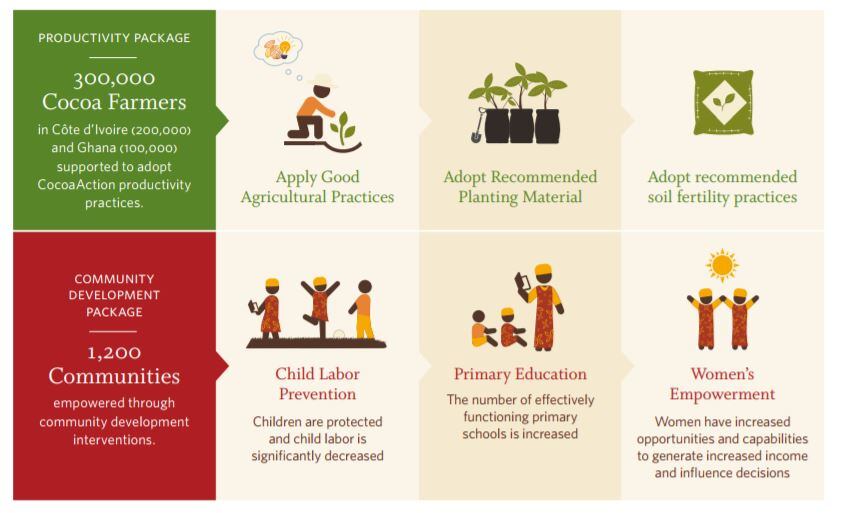
Is it making a difference?
CocoaAction aligns company programs such as Mondelēz’s Cocoa Life, Nestlé’s Cocoa Plan and Mars’ Vision for Change against common key performance indicators (KPIs).
While 2016 was the first intervention year for CocoaAction, many company programs have existed for a number of years.
With cocoa prices crashing to 10-year low on the New York market in Q1 this year and studies suggesting Ivorian farmers earn less than $1 a day are their efforts having a positive impact?
"Where we see a lot of progress is on the environmental issues,” said Desai.
She said WCF and CocoaAction members have worked together with the Ivorian governments for a regional approach on tackling cocoa swollen shoot virus (CSSV).
The disease destroys as much as 15% of global cocoa production each year, said CocoaAction’s report.
Yields: 523 kg per hectare
CocoaAction’s 2016 annual report shows the starting point for yields of the 147,000 farmers reached so far:

"The 2017 report will show the difference in yields," said Desai.
CocoaAction hopes farmers reached will have annual yields of at least 700 kg per hectare by 2020.
But will 700 kg per hectare on average farm sizes of one to three hectares be enough to lift farmers out of poverty?
"Yields does not equal income. It doesn’t necessarily guarantee direct revenue - there's some many other factors affecting a farmer,” said Desai.
Income data
CocoaAction does not report data on farmer income.
Individual company data
CocoaAction’s annual report does not display individual company data. It says: "A comparison between individual member data is not recommended." Antonie Fountain, managing director of the Voice Network, recently said CocoaAction should report individual company data in the interests of full transparency, enabling NGOs and consumers to see which firms are pulling their weight. Desai said: "Our report allows us to look at some of the insights and trends. Each of our companies are very transparent about publishing their own results in their own annual reports.” She added the annual report is only a snapshot of aligned interventions and companies may be doing more beyond CocoaAction’s agreed measures.
Some companies have individually collected and reported income data, such as Barry Callebaut, but collated data from all CocoaAction companies on income is absent in the annual report.
Desai said income was not among the original metrics for CocoaAction, but said: "We're working on getting there...We always had a plan to do an impact assessment to include income - we're building that process as we speak."
Richard Scobey, president of WCF, told this site CocoaAction’s main aim is to align companies' sustainability programs.
"CocoaAction is not collecting that kind of detailed income and expenditure studies. That's not what we were set up to do,” he said.
How to boost income?
However, Scobey said a KPI on income may become part of the Cocoa & Forests Initiative, a joint efforts of major companies with the Ghanaian and Ivorian governments to address cocoa-driven deforestation.
"The goal of WCF is to boost the income of cocoa farmers so they are profitable and will stay in cocoa production over time."
He said industry will work to achieve this by boosting farmer productivity, diversifying farmer income from other crops and training farmers how to protect farms from climate change.
But has the industry focus on productivity created a production surplus of almost 400,000 MT for the 2016/17 season leading to a slump in prices to the detriment of farmers?
"The increase is not due to improved productivity," said Scobey. "The increase in production is largely due to the expansion of farming often in illegal areas such as protected forests."
Adoption rates
CocoaAction members have agreed on a productivity package for farmers comprised of three elements : Good agricultural practices (GAP), rehabilitation of farms and fertilizer use.
Only 3,100 of the 147,000 farmers reached by CocoaAction have adopted the full productivity package suggested by the training.
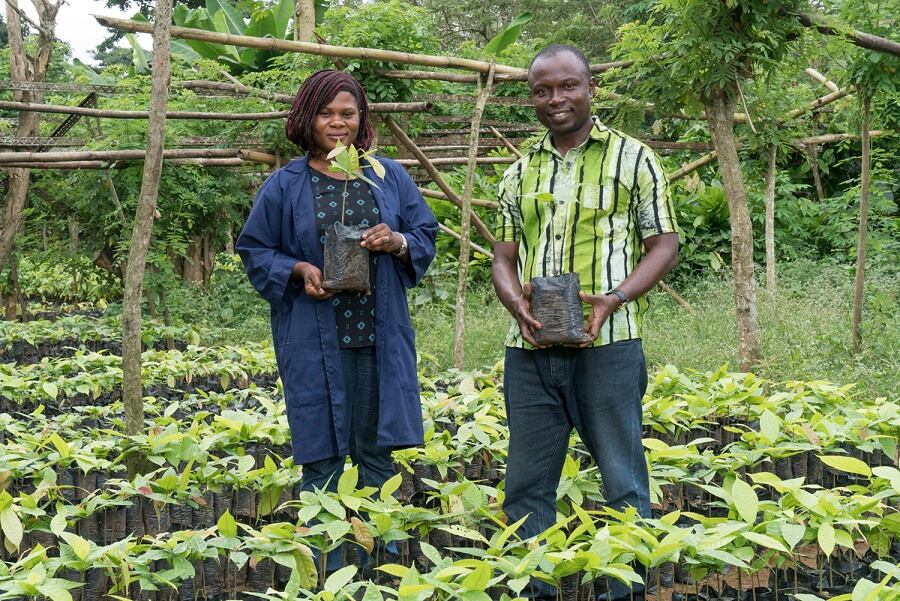
But Scobey said: "I see the results quite positively.
"We found good progress with the adoption of GAP. Almost 30% of farmers we reached in the first year had adopted four out of five important agricultural practices such as improved pruning."
"What we found less successful was the large scale rehabilitation of aged and diseased farms and adoption of fertilizer,” he said.
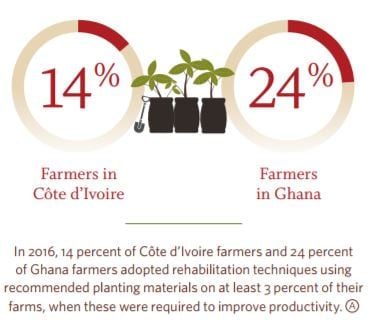
Improving rehab and replanting rates
The WCF president said the findings allow CocoaAction members to respond accordingly.
"For the adoption of farm rehabilitation about 15% of farmers we reached in the first year were able to do replanting,” said Scobey.
He said farmers were constrained by access to finance that allows them to purchase the resources needed to remove trees, to redesign their farms and to buy new planting material, while covering living costs while the farm is not productive.
Scobey said WCF has this year worked with the newly established $300m Impact Investment Fund for Land Degradation Neutrality of the United Nations to provide capital for farmers, helping them to accelerate replanting with improved planting material.
Better access to the right fertilizers
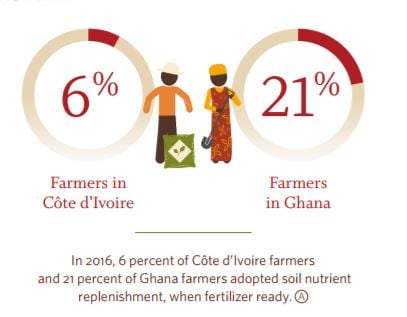
Scobey said while fertilizer was often subsidized by governments, farmers still have "a low level of income" to buy the fertilizer and often cannot find a fertilizer suitable for the soil on their farm.
"Quite frankly farmers are not convinced they have access to the right kinds of fertilizer," he said.
To tackle low uptake of fertilizer, WCF has launched a separate fertilizer research program – the ‘CocoaSoils Initiative’ - with Wageningen University and the International Institute for Tropical Agriculture.
The program will assess which fertilizers are most suitable to different types of soil.
WCF has also discussed eliminating Ghana’s fertilizer distribution program with the government, possibly replacing it with a framework promoting private sector delivery of fertilizers with more accessible prices.
The reach
CocoaAction has so far reached 147,000 farmers. It plans to reach 300,000 by 2020, around 6% of the 5m global cocoa farmers worldwide.
WCF’s members – not all of whom are part of CocoaAction – account for roughly 80% of the global supply.
But Desai said: “Getting 300,000 farmers as a data set and understanding what they are doing is significant…it's a starting point in order for us to scale.”
‘These are not the low hanging fruit’
Sako Warren, executive secretary of the World Cocoa Farmers Organization (WCFO) said: "Most of the time these reports do not reflect the reality on the ground…When I talk to my members, especially in rural areas, nobody tells me they have heard of CocoaAction.”
He alleged farmers within CocoaAction are often close to urban areas and ports and part of organized groups or cooperatives, which make up a small percentage of the cocoa output.
He said there are around 1m smallholders in Ghana producing 500,000 metric tons (MT) of the 700,000 MT annual crop with only 200,000 MT coming from coops or organized groups.
CocoaAction does not prescribe which farmers companies should work with. It is for companies to decide.
Scobey said: "Our farming population in CocoaAction constitutes a very diverse group of small farmers scattered all over the country."
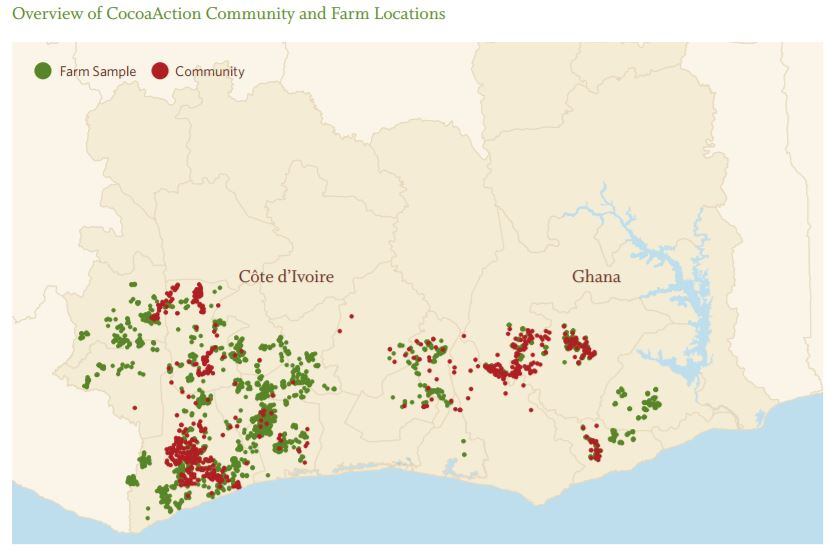
"These are not the low hanging fruit or farmers who are most successful and located near urban areas or cocoa markets.”
"...But by design we want to be investing in the cocoa farmers who have the scope and potential to be profitable and have good capacity."
He said many of the lower capacity farmers are those who have encroached into protected forests.
"What we need to do is transition those lower capacity farmers growing cocoa in illegal areas out of cocoa into other alternative livelihoods,” said the WCF president.
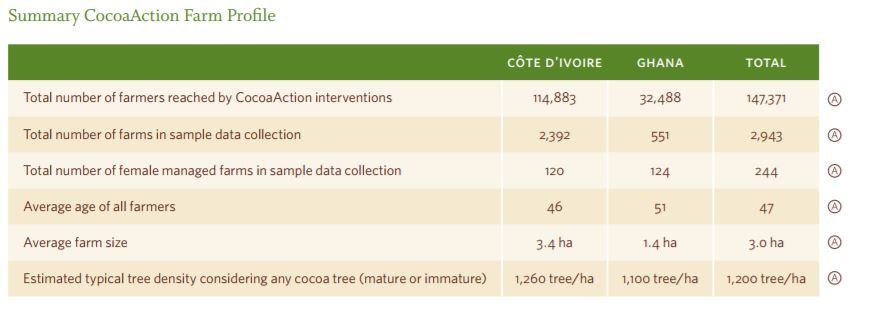
Desai said the 2016 data allows companies to learn from each other about the types of interventions that are working.
See CocoaAction’s five-year roadmap published in October 2016 for further details.
